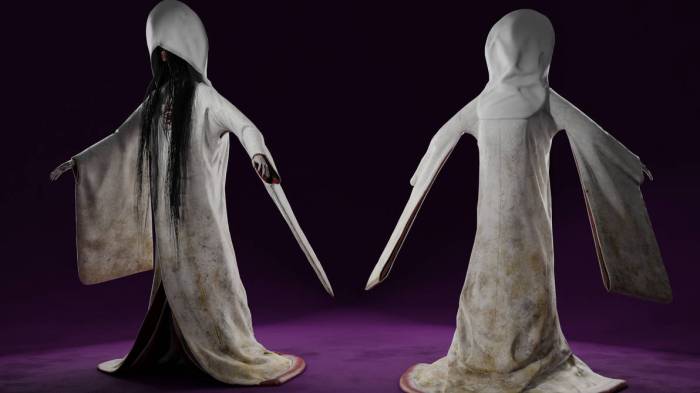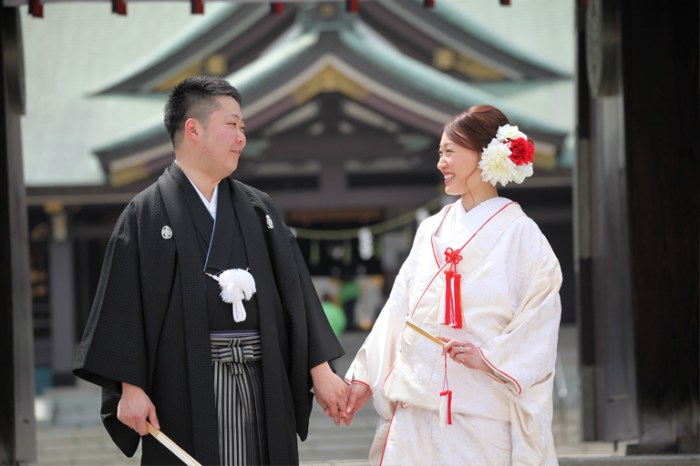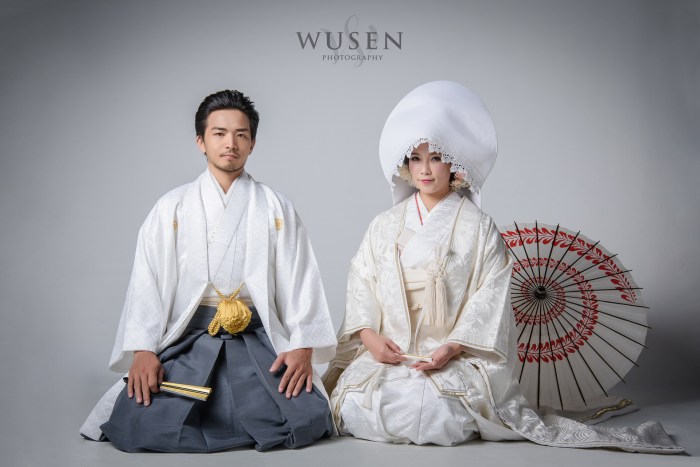Japanese Wedding Dress Kimono A Timeless Tradition
The History of the Japanese Wedding Kimono
Japanese wedding dress kimono – The Japanese wedding kimono, a symbol of tradition and beauty, boasts a rich history interwoven with cultural significance and evolving aesthetics. Its evolution reflects societal changes and artistic innovations across centuries.
Evolution of the Shiromuku
The Shiromuku, the iconic white wedding kimono, didn’t emerge fully formed. Its development spans centuries, evolving from simpler, less ornate garments to the elaborate ensembles seen today. Early forms were likely simpler white robes, gradually incorporating more elaborate embroidery and layering over time. The addition of the decorative obi (sash) and accessories further enhanced its visual appeal and symbolic weight.
Modern variations maintain the core white aesthetic but often include subtle embellishments and variations in fabric and design, reflecting contemporary tastes while retaining traditional elements.
Historical Significance of Colors and Patterns

Source: wixmp.com
Color and pattern choices in Japanese wedding kimonos carry deep symbolic meaning. White (shiro) in the Shiromuku signifies purity, innocence, and the bride’s fresh start. Other colors, though less prevalent in the Shiromuku, appear in other wedding kimono styles. For instance, red (beni) represents good fortune and joy, while gold (kin) symbolizes wealth and prosperity. Common patterns, such as cranes (representing longevity and marital bliss) and auspicious flowers (symbolizing fertility and growth), further enhance the kimono’s symbolic richness.
Comparison of Shiromuku and Other Wedding Kimonos
While the Shiromuku is the most recognized style, other kimono types are also worn for Japanese weddings. The uchikake, a more ornate, heavily embroidered kimono worn over the Shiromuku, adds a layer of visual splendor. The iro-uchikake, a colorful uchikake, provides a vibrant alternative to the traditional white. The Shiromuku emphasizes purity and simplicity, contrasting with the opulent display of the uchikake which signifies celebration and good fortune.
The choice reflects personal preference and the specific wedding traditions followed.
Timeline of Key Developments in Japanese Wedding Kimono Design
A chronological overview highlights the evolution of Japanese wedding kimono design:
- Heian Period (794-1185): Simple white robes begin to be associated with weddings.
- Muromachi Period (1336-1573): Elaboration of the robes with subtle embroidery and layering begins.
- Edo Period (1603-1868): The Shiromuku starts to take its current form, with the addition of more elaborate embellishments.
- Meiji Period (1868-1912): Western influences begin to subtly impact kimono design.
- Modern Era: Variations in fabric, color, and embellishments become more common, reflecting individual preferences.
Types of Japanese Wedding Kimonos
Several types of white wedding kimonos exist, each with unique features and symbolic significance. Understanding these variations provides insight into the nuances of Japanese wedding attire.
Variations of White Wedding Kimonos
The following table details different types of white wedding kimonos:
| Kimono Type | Description | Symbolism | Notable Features |
|---|---|---|---|
| Shiromuku | The quintessential white wedding kimono, symbolizing purity and new beginnings. | Purity, innocence, new beginnings. | Typically five layers, including a white hakama (trousers). |
| Uchikake (over the Shiromuku) | An ornate over-kimono worn over the Shiromuku, adding visual richness. | Celebration, good fortune. | Heavily embroidered, often with vibrant colors and auspicious patterns. |
| Iro-Uchikake | A colorful uchikake, offering a departure from the traditional white. | Joy, prosperity, good fortune. | Features various colors and designs, representing different auspicious meanings. |
| Kakeshita | A shorter, more casual kimono sometimes worn for informal wedding ceremonies. | Simplicity, elegance. | Less ornate than the Shiromuku or uchikake. |
Regional Variations in Japanese Wedding Kimono Styles
While the Shiromuku is a nationwide standard, subtle regional variations exist in the choice of fabrics, patterns, and embellishments. For instance, kimonos from Kyoto might feature more intricate embroidery compared to those from other regions. These variations often reflect local traditions and artistic styles, adding a unique character to the wedding attire.
The Symbolism and Meaning of Design Elements: Japanese Wedding Dress Kimono

Source: mizuno-shashinkan.com
The patterns and materials used in Japanese wedding kimonos are not merely decorative; they carry profound cultural and symbolic weight. Understanding these elements offers a deeper appreciation of the kimono’s significance.
Symbolic Meanings of Common Patterns
Cranes, frequently depicted on wedding kimonos, represent longevity and marital bliss, symbolizing a long and happy life together. Various flowers, like cherry blossoms (representing fleeting beauty and new beginnings) and wisteria (symbolizing longevity and good fortune), add layers of symbolic richness. The specific patterns chosen often reflect personal preferences and hopes for the marriage.
Significance of White
The color white in a Japanese wedding context signifies purity, innocence, and the bride’s fresh start in her new life. It symbolizes a clean slate, free from past burdens, and represents the beginning of a new chapter.
Cultural Implications of Fabrics and Embellishments
The choice of fabric also holds significance. High-quality silks, often used in formal wedding kimonos, indicate the family’s status and commitment to the wedding. Embellishments, such as intricate embroidery and gold leaf, add to the kimono’s visual opulence and symbolic value, reflecting the celebration and auspicious nature of the event.
Visual Representation of a Key Design Element
The crane, often depicted in flight, symbolizes the couple’s journey together, soaring towards a future filled with happiness and longevity. Its elegant form and graceful movements visually represent the beauty and harmony of a successful marriage. The detailed depiction of feathers and the dynamic pose emphasize the vitality and strength of the marital bond.
The Modern Japanese Wedding Kimono

Source: behance.net
While tradition remains central, modern interpretations of the Japanese wedding kimono demonstrate a fascinating blend of classic aesthetics and contemporary design sensibilities.
Traditional vs. Modern Interpretations
Modern interpretations often retain the core elements of the traditional Shiromuku – the white color and symbolic patterns – but incorporate contemporary design elements. This could involve using modern fabrics, incorporating unique color accents, or simplifying traditional patterns for a more streamlined look. The overall effect is a kimono that reflects both the heritage of the past and the evolving style of the present.
Trends in Contemporary Wedding Kimono Designs, Japanese wedding dress kimono
Current trends showcase a move towards more personalized and individualized designs. Brides are increasingly choosing kimonos that reflect their unique personalities and styles, incorporating subtle deviations from traditional norms. This may involve adding modern embellishments, using less traditional color palettes, or choosing less formal kimono styles for the ceremony.
Influence of Western Fashion
Western fashion influences are subtle but discernible in contemporary Japanese wedding kimono designs. This might manifest as slightly more form-fitting silhouettes, the use of Western-inspired fabrics, or the integration of elements from other global fashion trends. These influences are carefully integrated to complement, rather than replace, the core elements of traditional design.
Key Differences Between Traditional and Modern Japanese Wedding Kimonos
- Fabric: Traditional kimonos primarily use silk; modern kimonos may incorporate other luxurious fabrics.
- Silhouette: Traditional kimonos are typically looser; modern ones may be more form-fitting.
- Color Palette: Traditional kimonos are primarily white; modern ones might include subtle color accents.
- Embellishments: Traditional kimonos feature intricate, traditional embroidery; modern ones might incorporate simpler or more contemporary designs.
- Overall Style: Traditional kimonos emphasize formality; modern ones can reflect a wider range of styles and preferences.
The Process of Wearing a Japanese Wedding Kimono
Donning a traditional Japanese wedding kimono is a complex and meticulous process, requiring skill and attention to detail. Several layers of garments and accessories are involved.
Steps Involved in Dressing a Bride
The process of dressing a bride in a traditional wedding kimono is a detailed and time-consuming ritual, often involving multiple assistants. The undergarments, including a juban (under-kimono), koshihimo (sash), and nagajuban (long under-kimono), are carefully put in place before the kimono itself. The kimono is then layered and adjusted for a perfect fit. The obi, a wide sash, is meticulously tied, requiring skill and precision.
Finally, the accessories, including hair ornaments and jewelry, are added to complete the look.
Role of Accessories and Undergarments
Undergarments provide a smooth base for the kimono, ensuring a clean and elegant look. The obi not only holds the kimono in place but is also a significant decorative element. Accessories, like hair ornaments and jewelry, add a personal touch and complete the bridal ensemble. Each element plays a crucial role in achieving the desired aesthetic and symbolic effect.
Drape and Adjustment of the Kimono
The kimono is carefully draped over the body, ensuring it falls smoothly and gracefully. Adjustments are made to ensure a perfect fit, with the layers falling evenly and without wrinkles. The obi is meticulously tied, creating a structured and elegant silhouette. The entire process requires skill and precision, resulting in a flawless and aesthetically pleasing presentation.
Step-by-Step Guide to Kimono Dressing
- Put on the juban (under-kimono).
- Secure the koshihimo (sash) around the waist.
- Put on the nagajuban (long under-kimono).
- Layer the kimono carefully over the undergarments.
- Adjust the kimono for a proper fit.
- Tie the obi (sash) securely and elegantly.
- Add accessories like hair ornaments and jewelry.
The Cost and Availability of Japanese Wedding Kimonos
The cost of a Japanese wedding kimono varies widely depending on several factors. Potential brides also have the choice of renting or purchasing the kimono.
Factors Influencing the Cost
Several factors influence the cost of a Japanese wedding kimono, including the quality of the fabric (silk grade and type), the intricacy of the embroidery, the age and rarity of the kimono, and the reputation of the designer or vendor. Custom-made kimonos naturally cost significantly more than ready-made or rental options.
Renting vs. Purchasing
Renting a kimono is a more cost-effective option, especially for those who only need it for a single event. Purchasing, however, allows for ownership and the potential for future use or resale. The decision depends on budget, personal preference, and the intended use of the kimono.
Finding Reputable Vendors or Rental Shops
Reputable kimono rental shops and vendors can be found both online and in major cities with significant Japanese populations. Reviews and recommendations from other brides are valuable resources when choosing a vendor. It’s crucial to check the quality of the kimono, the terms of rental or purchase, and the overall reputation of the business.
Renting vs. Buying: A Comparison
- Renting: Lower initial cost, less storage space needed, but limited choice and no ownership.
- Buying: Higher initial cost, requires storage space, but offers greater choice, ownership, and potential resale value.
Q&A
How long does it take to put on a Japanese wedding kimono?
Putting on a Japanese wedding kimono is a complex process that can take several hours, often requiring the assistance of professionals.
Are there specific etiquette rules for wearing a Japanese wedding kimono?
Yes, there are specific etiquette rules, including how to properly sit, walk, and interact with others while wearing a kimono.
What is the average cost of renting versus buying a Japanese wedding kimono?
Renting a high-quality kimono can range from several hundred to over a thousand dollars, while purchasing one can cost significantly more, depending on the fabric, craftsmanship, and embellishments.
Can I wear a Japanese wedding kimono if I’m not Japanese?
While traditionally worn by Japanese brides, there’s no restriction on who can wear a Japanese wedding kimono; however, cultural sensitivity and respect for the tradition are important.
















